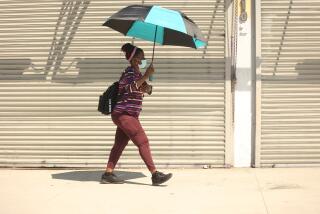Trying to save kids in hot cars
An urgent federal government warning solved one crisis for children in the mid-1990s, but laid the groundwork for another tragic problem a decade later.
After small children were killed by powerful air bags in the early 1990s, the federal government issued a recommendation -- put all babies in rear-facing carriers in the rear seat and put young children in the rear seat, as well.
Deaths dropped from a peak of 60 in 1995 to zero by 2002. The solution included a new generation of air bags. Mission accomplished.
But there was an unintended consequence. Parents somehow began to forget they put their babies in those rear-facing seats. And when these kids were left trapped in cars parked in the sun, they were handed a death sentence.
Child deaths from heat exposure doubled from 20 annually in the mid-1990s to 40 in 2004. Last year, the number stood at 35.
Everybody knows how hot a car gets parked in the sun, but few can appreciate how quickly the temperature accelerates.
Even on a day with moderate temperatures, a car’s indoor air can reach more than 160 degrees. A car can heat up to a fatal temperature within 10 to 15 minutes on a hot day. Children have died in cars even on days when the outdoor temperature was as low as 70 degrees.
It’s not just the air temperature that kills. Heat radiates from windows and other surfaces, raising the effective temperature for anybody stuck inside, said Larry Baraff, a UCLA pediatric emergency doctor.
Adults, of course, can get out. Young children cannot. As temperatures rise above 100 degrees inside the car, the cooling system of a trapped child is overwhelmed, Baraff said.
The human body sheds heat in two ways: radiating it off the skin and sweating. Because the human body runs an internal temperature of about 98 degrees, it cannot cool itself by radiation much above that. In a hot car, the reverse occurs. Dashboards and other surfaces can reach 200 degrees.
Evaporation does little to help. Babies are often shrouded in clothing. Until that clothing is soaked, there is little evaporative cooling. By the time a baby’s core temperature reaches 106 degrees, death is near.
The solution may seem obvious: Parents should not leave their kids in the car. “Personal responsibility” advocates would put the onus on these parents and argue that the government should not play a role. Indeed, some readers of last week’s column on this issue have contacted me to say they don’t want to have to pay anything for a safety system to prevent such deaths.
Those tough views appear to be in the minority, even among those who generally oppose government regulation. Doctors, safety experts and child advocates say innocent kids deserve to be protected from forgetful, ignorant or negligent parents.
The problem is -- how?
Janette Fennell, executive director of a safety organization called Kids and Cars, has pioneered the study of such deaths and strongly urges a system that would sound an alarm if kids were left unattended in a car. She advocates such a system be installed by automakers.
It’s a complex task, because some of the affected kids would be using baby seats purchased separately. It would require installing a weight or motion sensor that would trigger an alarm when the driver leaves the vehicle but a baby is in the rear seat.
The potential for false warnings seems obvious. What happens if a baby is with its aunt in the rear seat, for example? Nobody likes alarms that sound at the wrong times.
Fennell said automakers have the technology in hand for such an alarm, but the issue is stalled politically.
Others suggest that such a sensor could automatically roll down the windows or even start up the air conditioner. Such concepts involve many unknowns that would require a lot of study.
Could some of these kids be saved by a simple ventilation system to cool down the interior of cars, a feature that would also improve the comfort of adults? Experts have mixed opinions. In some cases, parents might think a ventilation system would make it safe to leave their kids in a parked car and would do it more often.
Safety devices sometimes do increase reckless behavior, according to Sam Peltzman, a University of Chicago economist who pioneered research into what he calls “safety offsets.” Peltzman said studies showed that not as many people as expected were saved by seat belts because some drove less carefully when belted.
Clarence Ditlow, executive director of the Center for Auto Safety, rejects that kind of thinking: “If it can help save the lives of babies, we are for it.”
An active ventilation system can reduce interior temperatures by more than 15 degrees, not enough for the worst situations but good enough to keep the interior temperatures well below the dangerous 100-degree mark on moderate days.
Mazda pioneered a solar cell powered ventilation fan in the early 1990s, but pulled it off the market for unknown reasons. Audi now offers a similar solar-powered ventilation system as a $600 to $650 option on two models. Mercedes-Benz offers such a system on the top of its line.
Joan Claybrook, president of Public Citizen, believes consumers would see the value of a ventilation system that improves the initial comfort of a car after it has been parked in the sun.
If it could help prevent some deaths, it would be a valid safety improvement, she added.
Ralph Vartabedian can be reached at [email protected].
More to Read
Sign up for Essential California
The most important California stories and recommendations in your inbox every morning.
You may occasionally receive promotional content from the Los Angeles Times.










